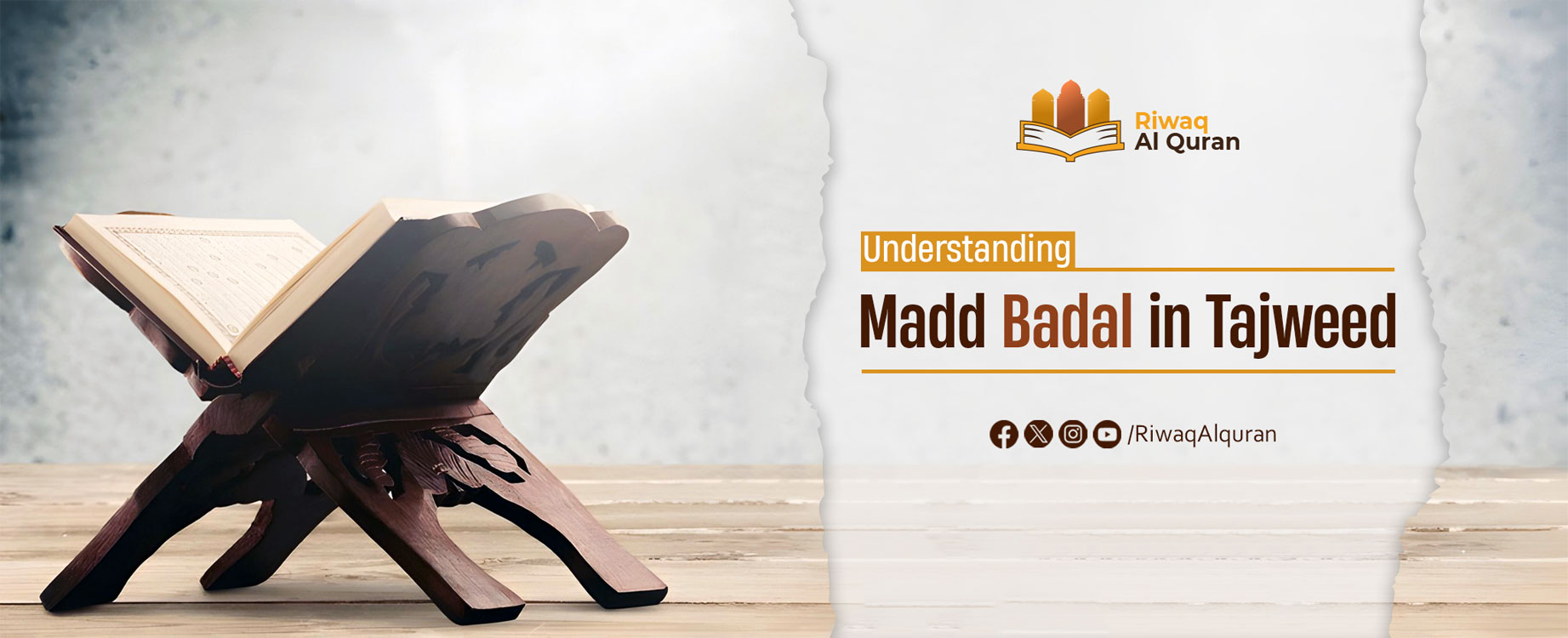Madd Al-Badal is a Tajweed rule where two consecutive hamzas in a word, with the second one having a Sukoon, transform into a Madd letter (Alif, Waw, or Ya) to ease pronunciation. This elongation occurs for two counts and is essential for smooth Quranic recitation, ensuring clarity and rhythm. It only applies when both hamzas are in the same word and helps improve recitation accuracy. Examples include آمَنُوا and إِيمَانًا, where the second hamza changes based on the vowel of the first.
Tajweed, which includes specific rules for the correct and most beautiful reading of the Quran, aims at the correct pronunciation of the letters of the Quran and a mistake-free reading. As a matter of fact, we can say that the founder of this science was our Prophet PBUH. The Holy Quran was taught to our master by Gabriel with Tajweed and He taught his companions that way. It has also reached us.
Madd Al Badal is one of the Tajweed topics that aim to be accurate in reading. Having finished the types of Madd in Tajweed, we will take a look at this tajweed rule and know different examples of it in this article InshaAllah.
Table of Contents
What Is Madd Badal?
Madd Al-Badal meaning in Arabic is when two hamzas in the same word, the second with a Sukoon sign, come in succession, it is called Madd Badal to convert the second hamza to a Madd letter in the movement of the first hamza.
The reason for this rule is the pronunciation difficulty that occurs when two hamzas, (the second hamza has a Sukoon), come in succession. After taking a look at the rule and its pronunciation, you may realize that since you started reading the Quran, you have been applying this rule without realizing it. Let’s take a look!
How to Apply Madd Al Badal
If there are two Hamzas in a word, the first has a vowel, and the second has Sukoon. The second Hamza is converted from the vowel category of the first Hamza to the letter Madd (for example, if the first Hamza has a Dammah on it, the second Hamza is changed to و; if the first Hamza has a Kasrah, the second Hamza is changed to ي; and if the first Hamza has a Fathah, the second Hamza is changed to ا).
This transformation helps in making the pronunciation smoother and easier for the reader, as pronouncing two consecutive Hamzas with different vowel rules can be challenging. The replaced Madd letter is then elongated for two Harakahs, which is the standard duration for Madd Badal.
It is important to note that Madd Badal only applies when the two Hamzas occur in the same word. If the Hamzas are in separate words, this rule does not apply. Additionally, Madd Badal is not affected by pauses, as it is inherent in the structure of the word itself.
Madd Badal Examples:
For example:
- أُوتُوا – The first Hamza has a Dammah, and the second Hamza becomes a و.
- إِيمَانًا – The first Hamza has a Kasrah, so the second Hamza becomes a ي.
- آمَنُوا – The first Hamza has a Fathah, resulting in the second Hamza being ا.
The example of Madd Badal above shows that the hamza with the Sukoon (on the parts shown in orange) turns into a Madd letter in the type of Haraka of the preceding hamza so as to make the recitation of Allah’s book easier.


Madd Badal Examples in the Quran:
While the example وَأُوتِينَا is in verse 16 of Surah An-Naml, the example وَا۪يتَٓائِ appears in verse 90 of Surah An-Nahl. Here, our letter that has changed and turned into the letter Madd is sounded for two counts.
The Quran contains numerous instances of Madd Badal. Below are some examples of Madd Badal from the Quran, along with brief clarifications for each case:
- آمَنُوا (Surah Al-Baqarah: 3) – Alif after Hamzah.
- إِيمَانًا (Surah An-Nisa: 136) – Ya’ after Hamzah.
- أُوتُوا (Surah Al-Baqarah: 4) – Waw after Hamzah.
- آدَمَ (Surah Al-Baqarah: 31) – Alif after Hamzah.
- إِيمَانِهِمْ (Surah Al-Munafiqoon: 3) – Ya’ after Hamzah.
- أُوذُوا (Surah Aal-E-Imran: 186) – Waw after Hamzah.
- آزَرَ (Surah Al-An’am: 74) – Alif after Hamzah.
- إِيلَافِهِمْ (Surah Quraysh: 1) – Ya’ after Hamzah.
- أُولَٰئِكَ (Surah Al-Baqarah: 5) – Waw after Hamzah.
- آمَنَ (Surah Al-Baqarah: 285) – Alif after Hamzah.
Read more about: Madd Leen
What Are the Types of Madd Badal?
Madd Badal is a type of elongation that occurs when a Hamzah (ء) is followed by a Madd letter (Alif, Waw, or Ya’) in the same word. The elongation depends on the vowel (Harakah) applied to the first Hamzah. Below are the main types of Madd Badal:
1. Madd Badal of Fathah
This occurs when the first Hamzah has a Fathah (ـَ) and is followed by the Madd letter Alif (ا). For example, in آمَنُوا (Surah Al-Baqarah: 3), the first Hamzah has a Fathah, and the second Hamzah is replaced with Alif (ا), leading to an elongation of two Harakahs.
2. Madd Badal of Kasrah
This happens when the first Hamzah has a Kasrah (ـِ) and is followed by the Madd letter Ya’ (ي). An example is إِيمَانًا (Surah An-Nisa: 136), where the first Hamzah has a Kasrah, and the second Hamzah is replaced with Ya’ (ي), leading to a two-Harakat elongation.
3. Madd Badal of Dammah
This takes place when the first Hamzah has a Dammah (ـُ) and is followed by the Madd letter Waw (و). For example, أُوتُوا (Surah Al-Baqarah: 4) shows the first Hamzah with a Dammah, and the second Hamzah is replaced with Waw (و), for two Harakahs.
Each type of Madd Badal serves to make recitation smoother and more fluid, ensuring the flow of the Quranic recitation without interruption. These elongations are essential for proper Tajweed and contribute to the rhythm and beauty of the recitation.
What are Madd Al Badal’s rules?
Now that we know the meaning of Madd Al Badal and its types, let’s learn the condition to apply Madd Badal and some other rules related to it:
1. Cause of Elongation
Madd Al-Badal occurs when a vowel (Fatha, Damma, or Kasra) is followed by one of the letters Alif, Waw, or Yaa that has a sukoon. This combination forces the vowel to be elongated for a specific duration. The sukoon on the letter following the vowel prevents that letter from being pronounced, allowing the preceding vowel to be extended.
2. Length of Elongation
The elongation in Madd Al-Badal is held for two counts, which means the vowel sound should be extended for two beats, double the length of a normal vowel sound.
3. Position
Madd Al-Badal occurs when a vowel (Fatha, Damma, or Kasra) is followed directly by one of the three letters (Alif, Waw, or Yaa) that has a sukoon. There should be no other letters between the vowel and the letter with sukoon. The proper positioning of the vowel and the sukoon on the following letter is what allows the elongation.
4. Application
Madd Al-Badal is crucial for maintaining the correct pronunciation of words in the Quran. By applying this elongation, the reciter ensures that the rhythm and melody of the Quranic recitation are preserved, and it helps prevent errors in meaning caused by improper pronunciation. This rule contributes to the beauty and clarity of the recitation, a key element in Tajweed.
When Not to Apply Madd Badal?
To learn the conditions not to apply Madd Badal and understand the given examples better, let’s see an example in which this rule is not used: أَيْمَانَهُمْ
This word in the Quran does not have Madd Badal and its pronunciation is Aymaanahum. As you can see, Hamza’s Haraka is Fatha before the letter Yaa. For two beats to be sounded, the Haraka of Hamza should be Kasra. This distinction is crucial for correct recitation.
How to Learn Madd Badal Rules?
Learning Madd Al Badal can seem challenging at first, but with the right techniques and consistent practice, you can easily master it. Below are six practical steps to help you apply this Tajweed rule with confidence and accuracy.
1. Understand the Concept
To master Madd Al Badal, start by thoroughly understanding its definition and reason. Know that it occurs when two hamzas come in succession within a word, and the second is transformed into a Madd letter to ease pronunciation and make recitation smoother.
2. Study Examples in the Quran
Review examples such as وَأُوتِينَا in Surah An-Naml (16) and وَإِيتَاءِ in Surah An-Nahl (90). Practicing these examples helps solidify the rule and provides a clear understanding of its practical application.
3. Recognize Exceptions
Learn cases where Madd Badal is not applied, such as in أَيْمَانَهُمْ. Understanding these exceptions ensures clarity in the application and prevents any mistakes in Tajweed.
4. Practice Through Repetition
Repetition is key to mastering Madd Al Badal. Regularly recite Quranic verses containing this rule, focusing on proper elongation and pronunciation for two counts to ensure fluency in recitation.
5. Use Visual Aids and Tajweed Resources
Leverage resources like color-coded Tajweed Mushafs and apps that highlight Madd Badal instances. These tools make it easier to identify and practice the rule during recitation, even for beginners.
6. Test Yourself Regularly
Challenge yourself by identifying Madd Badal in new verses. Record your recitation and compare it to authentic recitations to spot errors and improve your mastery over time.


Best Quran Tajweed Course
Although Tajweed rules cover many topics, these rules are mainly for making reading easier and improving pronunciation. If you learn the Quran from experienced Quran teachers who have good Tajweed knowledge, applying the tajweed rules will develop as a natural process and this will become a habit to spontaneously recite the book of Allah SWT the proper way. If you want to learn more about tajweed, join our Special Online Quran lessons at Riwaq Al Quran! Click, contact us, and start your free trial lessons!
We offer several courses such as:
- Online courses for kids.
- Online Quran classes for kids and adults.
- Online Arabic courses
- Online Ijazah courses
- Online Islamic Studies courses.
Here are a sample of our set of Quran Courses that will be helpful for you:
- Online Tafseer Course: Delve into Quranic meanings with our insightful online Tafseer course.
- Noorani Qaida Online: Learn Quranic basics efficiently through our Noorani Qaida online program.
- Online Quran Recitation Course: Enhance Quranic recitation skills through our expert-led online course.
- Online Tajweed Classes: Master Tajweed rules for beautiful Quranic recitation in online classes.
- Quran Memorization Online Course: Memorize the Quran effectively with our specialized online memorization course.
- Online Qirat Course: Explore diverse Qirat styles with our comprehensive online Qirat course.
Online Quran Classes for Kids: Nurture a love for the Quran in kids through interactive online classes.
Conclusion
Madd Al Badal is crucial for perfecting Quranic recitation. By understanding its application and different types of elongation, you can enhance your Tajweed and ensure smoother, more accurate recitation. Consistent practice, repetition, and testing will help you apply this rule naturally, improving both your fluency and confidence.
Equally important is knowing when Madd AlBadal does not apply. Understanding the exceptions will prevent errors and ensure correct pronunciation. With dedication and practice, you’ll be able to recite the Quran beautifully, preserving its rhythm and meaning in line with the principles of Tajweed.




































